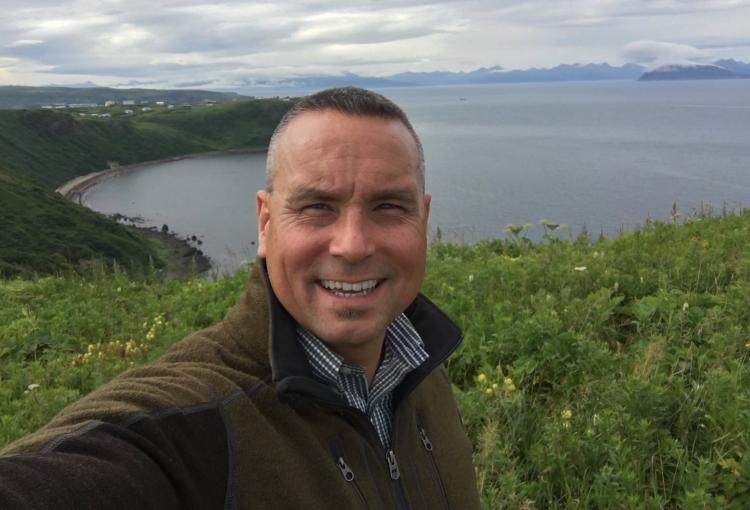The Spring 2021 ADRC Indigenous Aging Brain Health Series presents: A Conversation with Dr. Gary Ferguson on Traditional Foods, Ways of Healing, and Indigenous Elder Wisdom
Published in Dimensions Magazine - Spring 2021
Gary Ferguson (Aleut/Unangax) is a Qagan Tayagungin tribal member and licensed Naturopathic Doctor. He serves as Director of Outreach & Engagement, Institute for Research and Education to Advance Community Health (IREACH) at Washington State University. Dr. Ferguson has spent twenty years working across Alaska to address the social, economic, cultural and environmental factors that contribute to the health and well-being of Alaskans. His past positions include providing clinical services to his home region at Eastern Aleutian Tribes and serving as a Director at the Alaska Native Tribal Health Consortium and CEO of the Rural Alaska Community Action Program.
Now, the ADRC welcomes his collaboration with the ADRC Outreach, Recruitment & Engagement Core, where he adds his expertise to our efforts in outreach to American Indian and Alaska Native communities, in partnership with IREACH’s Partnerships for Native Health. We spoke with Dr. Ferguson about his life and work to promote the wellbeing of Alaska Native communities through a renewed emphasis on traditional foods and ways of healing, guided by the wisdom and knowledge of Indigenous elders and tribal doctors.
How has your heritage and connection to Indigenous culture and belief systems influenced your philosophy in life?
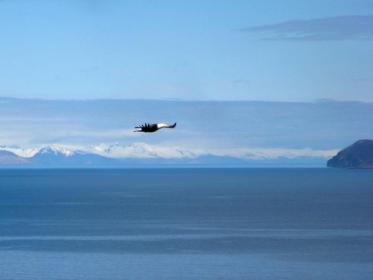
Bald eagle fly-by at Sand Point, AK. Credit: Jeff Fox. Public domain
I grew up in a southwest part of Alaska in the small Shumagin Islands fishing community of Sand Point. This is a place where a lot of tribal communities came together, along with immigrants from Scandinavia and Russia. Many of us reflect that diversity. We grew up listening to an eclectic mix of Scandinavian schottische and polka music, with people playing accordion. You will see Alaskan Native elders playing the accordion today. It hasn't been picked up as much by the younger generations, but elders still play during some of our gatherings. My guiding philosophy is that we're spiritual beings, living a physical existence, and we're here for a reason. I grew up with that belief as a part of my philosophy, and that perspective translated into my work in healing. I continue to have passion for ceremony in ways that honor our Creator. I look at the importance of our belief systems and how that relates to our wellbeing, through a sense of security and the spiritual knowledge that you're in a place where you can make a difference.
What sparked your interest in traditional healing and food?
After I finished undergraduate studies, I worked in my family’s electric utility business, and I was also volunteering as an EMT on the Aleutian peninsula. As I was serving these folks in crisis, I started to have these flashes of realization that a lot of the health emergencies were preventable. Those of us who served saw folks die right there in the clinic, and there was unfortunately a lot of vicarious trauma. I knew that emergency medicine was going to burn me out. So, I started studying nutrition and exercise. That change helped shift my priorities, as I looked instead at what can I do from a nutrition perspective, for example, by eating local and traditional foods. I think it is powerful to be connected to your local food system.
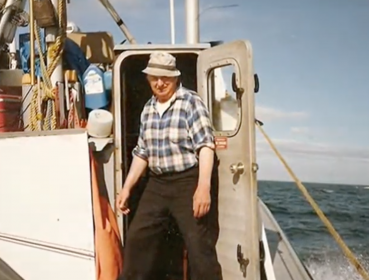
The late Emil Gundersen, Gary Ferguson's grandfather. Courtesy, Dr. Gary Ferguson
I eventually went to medical school to study naturopathic medicine because I was fascinated by our traditional and botanical medicines, and Indigenous ways of knowing and understanding that food is medicine. Hippocrates said, ‘Let food be thy medicine and medicine be thy food’—but Indigenous cultures have been saying that food is medicine for thousands of years and, even beyond that, nature, ceremony, and culture are medicine. These tenets from Indigenous cultures informed and inspired me to dig a little bit deeper into these knowledge systems.
What are some lessons on healing from Indigenous knowledge systems?
I have had the honor of studying with some of our tribal doctors. Dr. Rita Pitka Blumenstein is one of my close friends and mentors. She is a Yup'ik tribal doctor, now in her 90s. She has helped me over the years to understand the deeper tenets of wisdom that come through tribal doctors and healers. As Dr. Blumenstein says, “We are free to be who we are – to create our own life out of our past, and out of the present. We are our ancestors. When we heal ourselves, we also heal our ancestors – our grandmothers, our grandfathers, and our children. When we heal ourselves, we heal Mother Earth.” As we pursue healing, as we are healthier, everything is healthier, because we're all connected. The deep wisdom that comes from Indigenous ways of knowing can help guide us into the future as we face pandemics and environmental challenges.
I'm a lifelong learner, a lifelong healer. And I always like to say “wounded healer,” because I feel that many of us have gone through much in our lives that have contributed to our ability to be a good healer. Because we've gone through pain ourselves, and we've had trauma, we’ve had to do the deep work of healing ourselves. And to me, to be a good healer is to understand that in healing, we also heal ourselves.
I’m influenced by the work on culture and resiliency by the late Dr. Gerald Mohatt who served as Director of the Center for Alaska Native Health Research at University of Alaska Fairbanks. The more that you're connected to your culture and where you come from, the more resilient you are. Indigenous youth who are engaged in traditional practices show less risk behavior. From a health systems perspective, that work contributed to my passion around how do we make sure that these traditional approaches to diet and cultural connectedness are available to tribal members.
What is the connection between health and food in the Alaskan community?
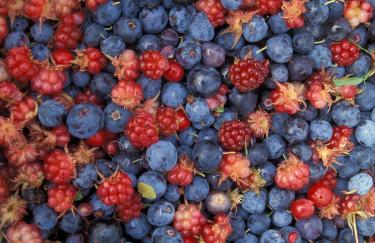
Alaskan wild berries from the Innoko National Wildlife Refuge, a mixture of true berries (blue Vaccinium uliginosum and red Vaccinium vitis-idaea) and aggregate fruits (red Rubus arcticus). Credit: U.S. Fish and Wildlife Service
After my doctoral studies, I was blessed to return to Alaska, where we have 229 federally recognized tribes, and a diversity of Indigenous knowledge. I worked at the Alaska Native Tribal Health Consortium and consulted with the Tribal Doctors in the Traditional Healing program at Southcentral Foundation. We had the honor of deeply engaging Alaska Native Elders through a research project called Helping Ourselves to Health. This was a USDA National Institutes of Food and Agriculture-funded research program on obesity and connection to changes in diets within the Yup'ik and Cup'ik population in southwest Alaska.
We found that traditional foods contributed to a huge amount of the nutrition that folks got in the region, even though it was a small part of their diet, because many folks had been embracing Western foods as primary due to the western influences of colonization. Part of the reason that many of us are seeing disease is a departure from some of these traditional foods and culture that promote wellbeing.
As we held focus groups with Elders in the Yukon–Kuskokwim Delta, they shared that they saw the need for more modern ways to prepare traditional foods and engage our younger generations, because many of them are giving up our language and our traditional foods. They asked, ‘How do we engage them?’ They noted that the Food Channel, and various other media, are really popular. So that gave us the building blocks to launch the ‘Store Outside Your Door’ webisode series to promote the knowledge and use of traditional foods in different communities in Alaska. Each video, available on YouTube, teaches how to harvest and prepare a nutritious traditional dish with a contemporary twist and science-based knowledge.
What is your perspective on how traditional ways of healing can be incorporated onto Western medicine?
A good chunk of our pharmacopeia in western medicine are analogues of compounds from plants that were used by Indigenous peoples all over the world. I think sometimes we don't really think of that enough when it comes to intellectual property. For example, the breast cancer drug tamoxifen comes from taxol, which comes from the Pacific Yew tree. This tree was long used for medicinal and spiritual purposes by the indigenous peoples of the Pacific Northwest, Southeast Alaska, and Canada. So, I feel like we have an opportunity moving forward to honor this wisdom in health care. Like, how do we respect these medicines, and how do we connect with the deeper knowledge behind that medicine, rather than just the key pharmaceutical constituents? Is there a ceremony with this medicine connected to deep cultural values? We could take more of a holistic approach in our health systems, and especially health systems serving Indigenous Peoples.
How are traditional cultural values around caring for elders, and respecting the wisdom of elders, being reflected in this current moment?
I was always close to my grandparents. It was the most beautiful thing to be able to help coordinate care for my grandmother Marina Gundersen in the last year of her life after a stroke, and then for my grandfather Emil Gundersen. He was an amazing long term cancer survivor who had a clear mind up until the day he died at 89. As I was spending time with my grandparents and seeing their needs, I looked around and started to bring my awareness to the fact that not all elders have social support services, family systems are fractured, and many are suffering. To me, it just went in the face of our cultural values and fueled my advocacy. I joined the Board of Directors of Access Alaska, which offers services to help Alaskans with disabilities to live independently. It was just a no-brainer. In the Tribal Health System, long term care isn't covered by Indian Health Service. And some of our tribal health agencies are doing amazing programs, but there are still many gaps. I feel that the more we can age in place, and have resources to do so, the better we can honor and care for our elders. Not every family can have their elder stay at home, because they just don't have the resources, or it's not safe for the elder or for the family. But if an elder needs to go into a skilled nursing facility or a nursing home, we need to have facilities that are more human, with more visiting and spirit. It’s heartbreaking to see elders in some of the facilities that can be so sterile and devoid of cultural foods or practices.
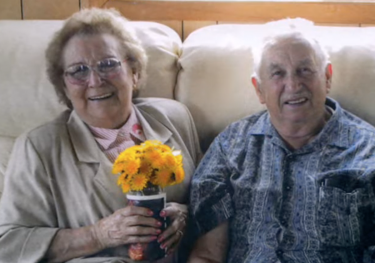
Gary's grandparents, Marina and Emil Gundersen. Courtesy, Dr. Gary Ferguson
But, recently, COVID has highlighted the deep respect our communities have for elder wisdom. A lot of communities have taken COVID very seriously and protected our elders with limiting travel and wearing masks. Some of our rural areas have no COVID cases and are close to 100% vaccinated. I think the lessons from the past informed us here. In pandemics and epidemics that we’ve experienced over our history, we had communities where sometimes only one or two people survived.
Elder wisdom is the way that culture gets perpetuated, and even one extra year of having an elder alive and vital in the community, means that young people and others get to engage that elder for that period of time. We value elders because they're our source of wisdom, knowledge, and cultural perpetuity. They hold wisdom on how to hunt, fish, and gather, how to understand the weather systems, and how generations have survived through oral storytelling. Elders help us to live healthy, vital lives, because they help inform us. They bring a healing energy to a room.
What traditional healing approaches are most helpful for elders living with dementia?
When I think of dementia and some of the agitation that can happen, I think of some of the Indigenous ways of healing that can really help a person calm down. Simple hand or foot massage, with good intention and energy, can be profound for elders. I think a lot of elders respond well when you have just that time and presence and put hands on somebody in a safe way, with permission. And, and having healthy touch that allows them to be more grounded. It comes down to just being present, connecting with somebody, and spending the time with them. I think that touch is an important part of healing. And, I feel like elders especially don't get enough touch.
I think that creating a comforting and caring environment really helps elders with dementia to be as high functioning as possible, and have those clear, lucid moments that are extra special. I feel like often they don't remember it the next day, but I think on a spiritual level, they really do. There's something very special in your relationship and connection with an elder with dementia, even if you don’t get back an acknowledgement. The gift is the relationship. It’s part of just showing up, of being respectful.
A way of respecting elders living with dementia is saying, “That’s so interesting.” or, “Yes, I remember that,” instead of, “Hey, I've heard that before.” We allow them to tell their stories. Lately, I've been playing music for my dad, who has early Alzheimer’s, and it brings forth such great memories and rich storytelling. I know what kind of music he likes because he was a musician, and it's been so fascinating and fun to evoke those memories. And it's also been emotional for him. There is a sense of loss and grieving, as he revisits traumas. It’s profoundly healing for him to share his stories and talk about his life. I feel like that's the gift that I also receive by spending time with him. •
This interview was conducted by Genevieve Wanucha, MS, Science Writer, UW ADRC/Memory and Brain Wellness Center for the ADRC Indigenous Aging Brain Health Series in the Spring 2021 Dimensions Magazine (forthcoming).
